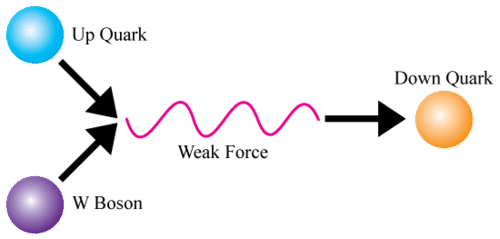20.2: Atomic Forces
- Page ID
- 2888

You’ve probably used items like those pictured here. What do all of them have in common? They are all used to hold things together. However, they do so in different ways. Like these different kinds of fasteners, there are different kinds of “fasteners” that hold together the subatomic particles inside atoms. The “fasteners” are called forces, and there are three different kinds of them at work inside the atom: electromagnetic force, strong nuclear force, and weak nuclear force.
Electromagnetic Force
Electromagnetic force is a force of attraction or repulsion between all electrically charged particles. This force is transferred between charged particles of matter by fundamental force-carrying particles called photons. Because of electromagnetic force, particles with opposite charges attract each other and particles with the same charge repel each other.
Inside the atom, two types of subatomic particles have electric charge: electrons, which have an electric charge of -1, and protons, which have an opposite but equal electric charge of +1. The model of an atom in the Figure below shows both types of charged particles. Protons are found inside the nucleus at the center of the atom, and they give the nucleus a positive charge. (There are also neutrons in the nucleus, but they have no electric charge.) Negative electrons stay in the area surrounding the positive nucleus because of the electromagnetic force of attraction between them.

Q: Why do you think protons cluster together in the nucleus of the atom instead of repelling each other because of their like charges?
A: The electromagnetic force of repulsion between positively charged protons is overcome by a stronger force, called the strong nuclear force.
Strong Nuclear Force
The strong nuclear force is a force of attraction between fundamental particles called quarks, which have a type of charge called color charge. The strong nuclear force is transferred between quarks by fundamental force-carrying particles called gluons. Both protons and neutrons consist of quarks. The exchange of gluons holds quarks together within a proton or neutron. Excess, or residual, strong force holds together protons and neutrons in the nucleus. The strong nuclear force is strong enough to overcome the electromagnetic force of repulsion pushing protons apart. Both forces are represented in the Figure below.

The types of quarks found in protons and neutrons are called up quarks (u) and down quarks (d). Each proton consists of two up quarks and one down quark (uud), and each neutron consists of one up quark and two down quarks (udd). This diagram represents two protons.
The strong nuclear force works only over very short distances. As a result, it isn’t effective if the nucleus gets too big. As more protons are added to the nucleus, the electromagnetic force of repulsion between them gets stronger, while the strong nuclear force of attraction between them gets weaker. This puts an upper limit on the number of protons an atom can have and remain stable. If atoms have more than 83 protons, the electromagnetic repulsion between them is greater than the strong nuclear force of attraction between them. This makes the nucleus unstable, or radioactive, so it breaks down. The following video discusses the strong nuclear force and its role in the atom.
Weak Nuclear Force
The weak nuclear force is transferred by the exchange of force-carrying fundamental particles called W and Z bosons. This force is also a very short-range force that works only within the nucleus of the atom. It is much weaker than the strong force or electromagnetic force that are also at work inside the atom. Unlike these other two forces, the weak nuclear force does not bind subatomic particles together in an atom. Instead, it changes subatomic particles from one type to another. The Figure below shows one way this can happen. In this figure, an up quark in a proton is changed by the weak force to a down quark. This changes the proton (uud) to a neutron (udd).

Q: If the weak force causes a proton to change to a neutron, how does this change the atom?
A: The resulting atom represents a different element. That’s because each element has a unique number of protons. For example, all atoms of helium have two protons. If one of the protons in a helium atom changes to a neutron, the resulting atom would have just one proton, so the atom would no longer be a helium atom. Instead it would be a hydrogen atom, because all hydrogen atoms have a single proton.
Launch the PLIX Interactive below to build a helium atom. Be sure to use the mass number and atomic number included in the periodic symbol of helium to help you determine the correct number of protons, neutrons and electrons that make up a helium atom:
Interactive Element
Summary
- The electromagnetic force of attraction between negative electrons and positive protons in the nucleus keeps electrons in the area surrounding the nucleus.
- The electromagnetic force of repulsion between positive protons in the nucleus is overcome by the strong nuclear force between protons and neutrons. This force holds the nucleus together.
- The weak nuclear force changes subatomic particles from one type to another. When protons change to neutrons, this changes atoms of one element to atoms of a different element.
Review
- Which subatomic particles are affected by electromagnetic force? How does this force affect them?
- What is the strong nuclear force? How does it hold the nucleus together?
- How does the weak nuclear force differ from the other fundamental forces inside the atom? How can it change an atom of one element to an atom of a different element?
Additional Resources
Real World Application: May the Force Be with You
Interactive: Subatomic Particle zoo
Videos:

